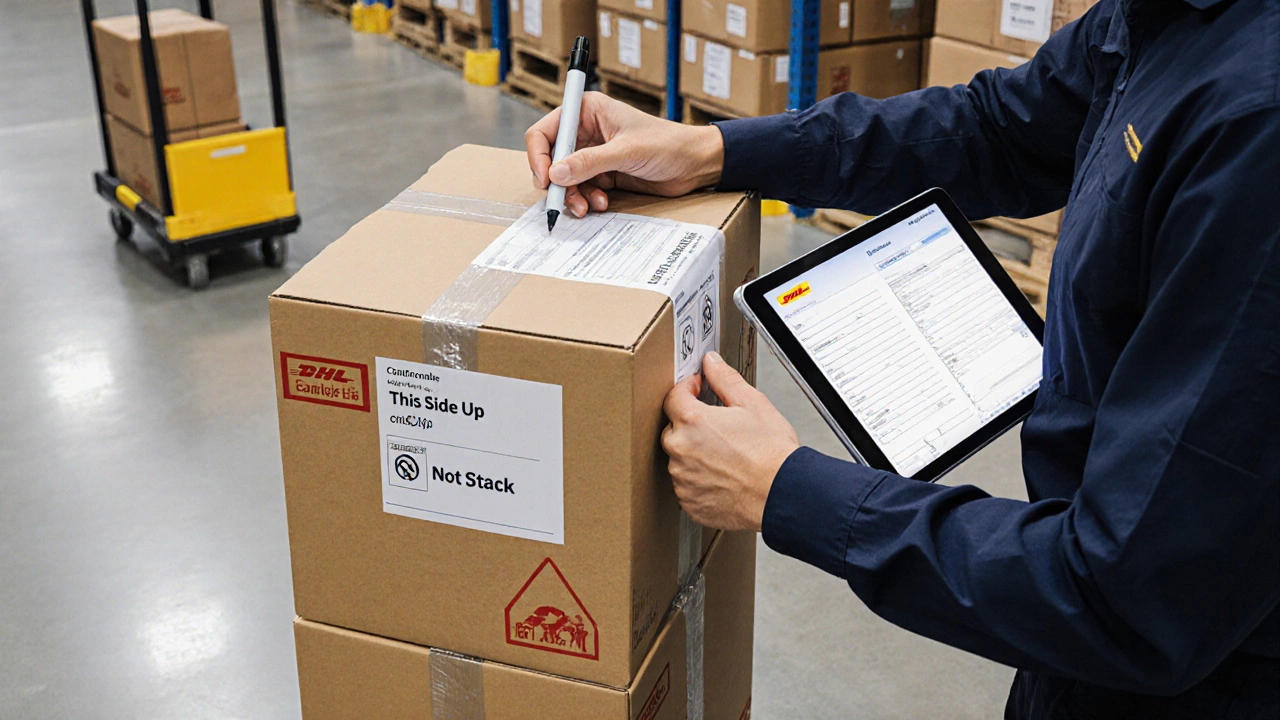Box Size Calculator for International Shipping
Determine the correct box size for your international shipment based on the article's recommendation of no more than 2 inches of empty space around contents.
Shipping a box overseas isn’t just about taping up a cardboard box and dropping it at the post office. If you get it wrong, your package could get stuck in customs, damaged in transit, or even rejected entirely. Millions of packages are delayed each year because of poor packaging-not because of bad carriers, but because the sender didn’t know how to prepare the box properly.
Start with the right box
Not all boxes are made equal. A flimsy Amazon shipping box might work for your local delivery, but it won’t survive a journey across oceans. For international shipping, use a new, double-walled corrugated cardboard box. These have extra layers of cardboard for strength and crush resistance. Avoid reusing old boxes unless they’re in near-perfect condition-tape residue, dents, or worn flaps can cause seals to fail mid-transit.Measure your items first. The box should fit snugly, with no more than 2 inches of empty space around the contents. Too much empty space means items can shift and break. Too little space and you won’t have room for padding. A good rule of thumb: if you can shake the box and hear things moving inside, it’s too big.
Protect fragile items properly
Fragile items like glassware, electronics, or ceramics need more than just bubble wrap. Wrap each item individually in at least two layers of bubble wrap, securing it with tape. For extra protection, use foam peanuts, air pillows, or crumpled kraft paper to fill gaps. Never rely on newspaper alone-it doesn’t cushion well and ink can transfer onto your items.Place heavier items at the bottom and lighter ones on top. If you’re shipping a set of dishes, stand them upright like books in a shelf, not stacked flat. This reduces pressure on the weakest point-the rim or edge. For electronics, remove batteries if possible. Many countries ban lithium batteries in checked luggage or air cargo unless they’re installed in the device.
Seal the box like a pro
Use reinforced packing tape-3-inch wide, polypropylene tape designed for shipping. Don’t use duct tape, masking tape, or rope. Duct tape peels off in humidity. Masking tape loses stickiness. Rope doesn’t seal.Apply tape in a strong “H” pattern across the top and bottom flaps. That means one strip across the center seam, then one on each side flap, overlapping the seam by at least 2 inches. This prevents the box from splitting open during handling. Seal all edges, including the bottom. A box that opens on the conveyor belt at the airport is a lost package.
Label clearly and correctly
Your address label must be printed, not handwritten. Smudged ink or messy handwriting causes delays. Use a permanent marker only if you must write by hand-but print if you can. Include:- Full recipient name
- Complete street address (no PO boxes unless accepted by the carrier)
- City, postal code, and country
- Phone number (required by most international carriers)
Place the label on the largest flat surface of the box. Don’t put it over a seam or corner. Put a second label on the side. If the box gets turned upside down, the label won’t be lost.
Mark the box with clear icons: “Fragile,” “This Side Up,” “Do Not Stack.” These don’t guarantee gentle handling, but they make handlers pause. Use standard ISO symbols so they’re understood globally.

Fill out customs forms accurately
This is where most packages get stuck. Every international shipment needs a customs declaration. Even if you’re sending a gift, you still need to declare it.Be specific. Don’t write “gift” or “samples.” Write: “1 ceramic coffee mug, value $18, made in China.” List every item separately. Include quantity, description, value in USD or EUR, and Harmonized System (HS) code if you know it. If you don’t know the HS code, use a free online tool like the International Trade Centre’s tariff database.
Undervaluing items to avoid duties is illegal and risky. Customs officials use AI to flag suspicious values. A $500 camera declared as $20 will get inspected-and possibly seized. Declare the real value. If you’re worried about duties, tell the recipient they may owe taxes upon arrival.
Choose the right carrier and service
Not all international carriers are the same. DHL, FedEx, and UPS offer reliable tracking and customs clearance. Royal Mail’s International Standard service is cheaper but slower and less trackable. If you’re shipping high-value items, go with a tracked, insured service.Check what each carrier allows. Some ban aerosols, batteries, liquids, or certain foods. Others require special permits for cosmetics or pharmaceuticals. Always check the carrier’s prohibited items list before you pack.
Insure your shipment
Standard shipping coverage rarely covers the full value of your goods. If you’re shipping a laptop, jewelry, or antique, buy extra insurance. Most carriers let you declare the value during checkout. Keep your receipt and photos of the packed items. If something goes wrong, you’ll need proof of value and condition.Some credit cards offer shipping insurance for purchases made with them. Check your card’s benefits before paying extra.
Keep a copy of everything
Before you hand over the box, take a photo of the packed contents. Save a digital copy of the customs form. Write down the tracking number. Email yourself a copy of the shipping label. If the package goes missing or gets held up, you’ll need this information to file a claim or contact customs.Tip: Write the tracking number on the outside of the box with a permanent marker, just in case the label peels off.
What not to ship
Some things are banned outright. Here’s a short list of common no-nos:- Live animals (including insects and plants)
- Firearms, ammunition, or explosives
- Drugs and prescription meds without paperwork
- Counterfeit goods or branded items without authorization
- Alcohol and tobacco (in most countries)
- Perishable food (cheese, meat, fresh fruit)
- Large quantities of cash or precious metals
Even if it’s legal in your country, it might be illegal in the destination. Always check the destination country’s customs website. For example, Australia bans all food, seeds, and wooden items without inspection. Brazil requires a tax ID for every import. The rules change often-don’t assume.
Final checklist before sealing
Before you hand your box to the carrier, run through this:- Box is new or in perfect condition
- Items are individually wrapped and cushioned
- Box is sealed with reinforced tape in an “H” pattern
- Labels are printed, clear, and placed on two sides
- Customs form is complete, accurate, and attached
- Insurance is purchased if needed
- Tracking number is written on the box
- You have a photo and digital copy of everything
If you’ve done all this, your package has a 95%+ chance of arriving safely and on time. International shipping isn’t complicated-it just requires attention to detail. Get the basics right, and you’ll save yourself weeks of stress, extra fees, and lost goods.


